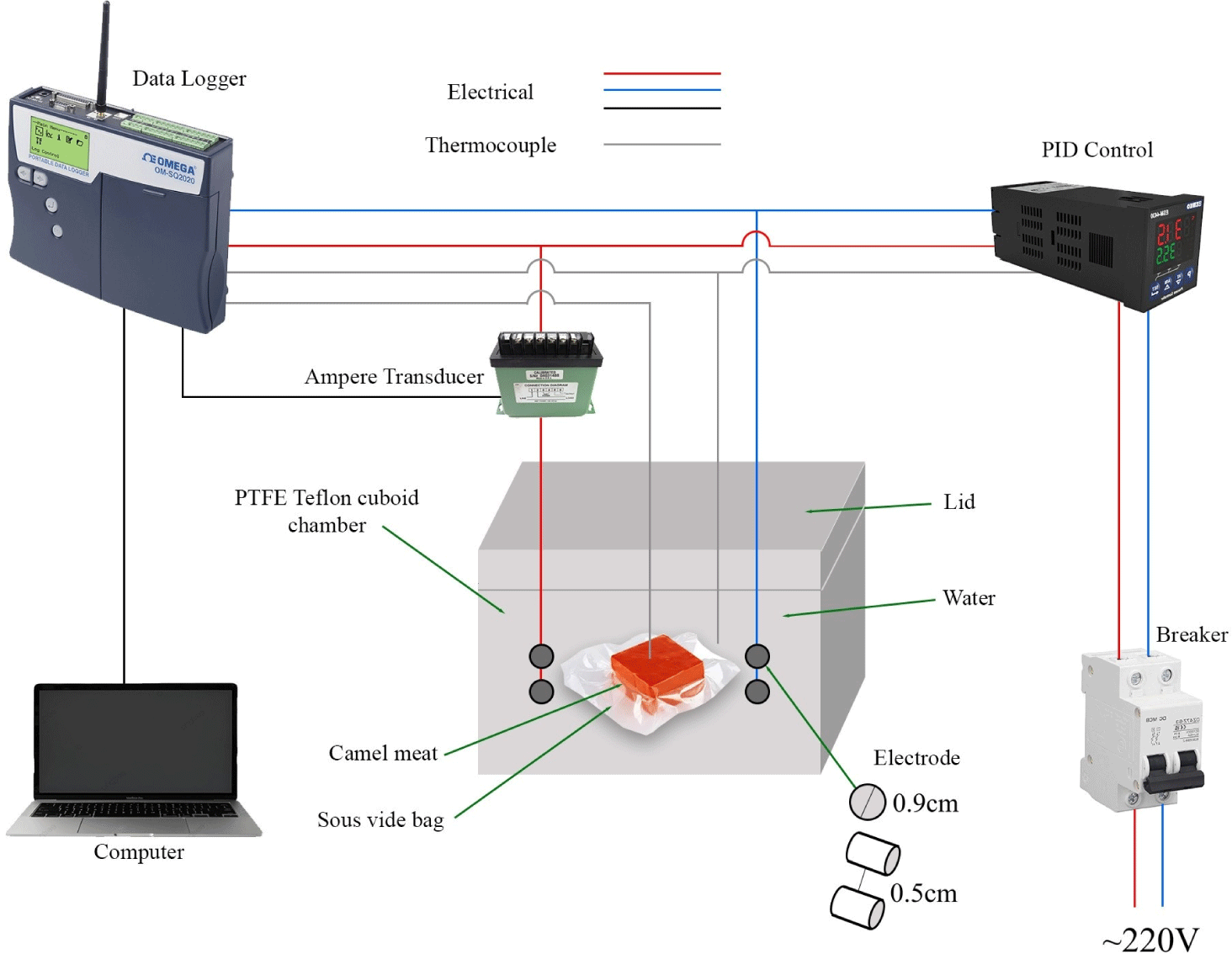Introduction
In the Middle East and North-East Africa, camel meat is a key source of protein, readily available to consumers. This trend is especially evident in Saudi Arabia, where the camel population approximates 2 million (Ministry of Environment Water & Agriculture, 2022), representing 5% of the global total (Food and Agricultural Organization of the United Nations [FAO], 2022). As a type of red meat, camel meat shares similarities with beef but offers additional nutritional benefits, such as lower intramuscular fat and cholesterol levels, which makes it a valuable and healthy protein source (Baba et al., 2021; Mohammed et al., 2020). However, traditional high-temperature cooking methods can negatively impact both the sensory qualities and thermophysical characteristics of camel meat, such as moisture content, texture, and heat transfer properties, often leading to losses in flavor, tenderness, and juiciness. Additionally, these conventional methods are often energy-intensive, prompting the need for more advanced cooking methods that can optimize both quality preservation and energy efficiency to support sustainable food processing.
Recent advancements in cooking technologies have introduced alternatives to conventional methods, notably sous vide (SV) and ohmic heating (OH). The SV technique involves vacuum-sealing food in plastic bags and cooking it at low temperatures (typically 65°C–90°C) for extended periods (2–8 h; Baldwin, 2012; Hobani et al., 2023). This method is known to preserve moisture, tenderness, and flavor, while minimizing nutrient loss and enhancing the sensory qualities of the meat (Christensen et al., 2012; del Pulgar et al., 2012; Naqvi et al., 2021). However, the energy-intensive nature of SV, due to prolonged cooking times, raises concerns about its energy efficiency, particularly in large-scale commercial applications (Laycock et al., 2003; Pathare and Roskilly, 2016). On the other hand, OH heats food by passing an electric current through it, thereby generating internal heat via ion movement (Alfaifi et al., 2023; Turgut et al., 2022); thus, it can achieve rapid, uniform heating and potentially lower energy consumption compared to conventional methods, which can result in significant energy savings (Aydin et al., 2020; Özcan et al., 2018; Yildiz-Turp et al., 2013). Nevertheless, OH has limitations, including potential protein degradation and texture changes, which can negatively impact the quality of the final product (Bozkurt and Icier, 2010; Dai et al., 2014). Thus, while both SV and OH have individual strengths, they also face the limitations of energy efficiency and quality preservation, respectively. Combining OH and SV techniques into a single, integrated ohmic-sous vide (OSV) system could potentially leverage the strengths of both methods while mitigating their individual limitations. This approach utilizes the energy-saving benefits of OH alongside the quality-preserving effects of SV, offering a balanced method suitable for high-quality camel meat cooking.
Addressing the energy inefficiencies of SV cooking and the potential quality degradation associated with OH has led to the hypothesis of a practical solution. This study aims to develop an OSV system, integrated with automated temperature control, to optimize both energy efficiency and meat quality. To assess the effectiveness of this system, the study evaluates its performance in terms of energy consumption rates and efficiency, as well as its impact on the thermophysical properties of camel meat across various cooking temperatures and times. The results are compared with those of the conventional SV method. The findings are expected to provide valuable insights into the commercial application of OSV cooking, paving the way for improved meat quality and greater sustainability in the food processing industry.
Materials and Methods
Camel meat samples were collected from shoulder cutlets of 12 male Majaheem breed in Saudi Arabia, purchased from a retail outlet 24 h post-slaughter. The shoulder cut was selected due to its desirable balance of tenderness and flavor, making it suitable for cooking. To ensure consistency, all animals were carefully selected to have a uniform age (7–8 mon), nutritional background, and sex. Upon arrival at the Food Process Engineering Laboratory at King Saud University, the external fat and connective tissue were trimmed from the samples. Shoulder cutlet samples were then sliced perpendicular to the muscle fibers, shaped into cubes measuring 6×6×6 cm, and vacuum-sealed in plastic bags. The bagged samples were stored at –20°C until the experiments were conducted. The total number of prepared samples was 120, which were tested using various combinations of cooking methods, times, and temperatures. Prior to treatment, the samples were thawed in a refrigerator at 3°C for 24 h (Dawood, 1995; Hobani et al., 2023; Suliman et al., 2011). The thawed samples were removed from the plastic bags and placed in vacuum seal cooking pouches (SousVide Supreme, Eades Appliance Technology, Broomfield, CO, USA), which were designed to withstand high temperatures and were safe for food use. The pouches were then vacuum-sealed using a vacuum sealer (Sous Vide Supreme Sealer VS3000, Eades Appliance Technology). Subsequently, the samples were cooked for varying durations (30, 60, 90, and 120 min) at temperatures of 70°C, 80°C, and 90°C. These specific cooking times and temperatures were selected to evaluate their effects on the energy consumption of the cooking techniques and the thermophysical characteristics of camel meat while also ensuring they fall within the safe ranges for meat cooking (Alfaifi et al., 2023; Hobani et al., 2023).
An OSV cooking system was designed and developed at the Food Process Engineering Laboratory at King Saud University. Fig. 1 illustrates the setup, which consisted of a Teflon cuboid chamber (15×15×13 cm). Four cylindrical titanium electrodes (Ti-anode Fabricators, Chennai, India) with a platinum coating of 0.9 cm were utilized, two of which were positioned parallel to each other along the left and right sides of the chamber walls. The setup included a 220 V power supply delivering an alternating current at 60 Hz; a Teflon-coated Thermocouple (T-type, Omega Instrument, Stamford, CT, USA) for temperature measurement, a calibrated current transducer (CTRS-050x5, Ohio Semitronics, Hilliard, OH, USA); a data logger to record current, voltage, and temperature during cooking; and a PID controller (ESM-4430, Emko Elektronik, Bursa, Turkey), which was used for temperature regulation.
For comparison, the camel meat samples were also SV cooked by immersing them in a water bath (GFL Water Bath, Model 1083, LAUDA Technology Laboratory Equipment, Lauda-Königshofen, Germany) at the same temperature and time combinations used in the OSV experiments. Fig. 2 depicts the complete experimental setup.
During the cooking process, a data logger (OM-3000, Omega Engineering, Auckland, New Zealand) was used to record voltage, current, and temperature at 1 second intervals. Current measurements were facilitated by a CTRS-050x5 current transducer (Ohio Semitronics), while temperature was measured using a Teflon-coated Thermocouple (T-type, Omega Instrument). Electrical energy consumption (Qin, kWh) was calculated using the following Eq. (1) (Aydin et al., 2020):
Where I is current (A), V is voltage (V), and Δt is heating time (h).
The transferred heat energy (Qout, kJ) from the cooking systems was calculated using the following Eq. (2) (Jo and Park, 2019; Soisungwan et al., 2020):
Where mc and mw are the masses of camel meat sample and water (kg), respectively, and CP,c and CP,w are the specific heat values of camel meat and water (kJ/kg·K), respectively. Ti,c and Tf,c represent the initial and final temperatures of the camel meat (°C), respectively, while Ti,w and Tf,w refer to the initial and final temperatures of the water, respectively.
The specific energy consumption (SEC; kWh/kg), of cooking operations was calculated using the following Eq. (3) (Lakshmi et al., 2007; Pathare and Roskilly, 2016):
The energy efficiency (E), %, of the cooking operations was determined using the following Eq. (4) (Aydin et al., 2020; Oluwole-ojo et al., 2023):
Where Qin is the energy input in kWs.
The thermal characteristics of fresh and cooked camel meat, including thermal conductivity (k), thermal diffusivity (α), and specific heat (Cp), were measured at room temperature (20°C±2) using a thermal characteristics meter (KD2 Pro, Decagon Devices, Pullman, WA, USA). The measurements were taken by inserting a probe parallel to the protein fibers of the camel meat, and the readings were recorded automatically by the device.
The density of the cooked camel meat was determined using the liquid displacement method with toluene and a density balance (PG 203-S, Mettler-Toledo, Greifensee, Switzerland). The device directly displayed the result (Hobani et al., 2023).
The cooking yield of camel meat was calculated as the difference between the weight of the camel meat before and after cooking. The weights of the samples were measured using a sensitive balance with a precision of 0.01 g (2100/C/2, Radwag Wagi Elektroniczne, Radom, Poland). The cooking yield was calculated using the following Eq. (5):
The experimental design employed a completely randomized design with a three-way factorial arrangement (2×3×4) to analyze the interactions between cooking method, temperature, and time. This design was supplemented by various two-way factorial arrangements to explore specific interactions between pairs of treatment factors, each with different levels: a 2×3 arrangement for cooking method and temperature (examining two cooking methods: OSV vs. SV across three temperature levels: 70°C, 80°C, and 90°C), a 3×4 arrangement for temperature and time (exploring three temperature levels: 70°C, 80°C, and 90°C across four time intervals: 30, 60, 90, and 120 min), and a 2×4 arrangement for cooking method and time (evaluating two cooking methods: OSV and SV across four time intervals: 30, 60, 90, and 120 min). Each experimental condition was replicated five times to enhance the reliability of the results, resulting in a total of 120 experiments conducted.
The Shapiro-Wilk test was used to assess the normality of the data, validating the assumptions necessary for analysis of variance (ANOVA). Data analysis was conducted using ANOVA within the general linear model framework, utilizing SPSS version 27 (IBM, Armonk, NY, USA). Results were reported as mean±SD, with statistical comparisons made for independent factors. If significant differences (p<0.05) were identified, post hoc analysis using the least significant difference test was performed to further examine differences between treatment means. This statistical approach provided a comprehensive analysis of the main effects and interactions among the factors, setting the stage for the detailed results and discussion. The following statistical model was used:
Where Yijk represents the response variable; μ is the overall mean; Ai indicates the effect of cooking method (OSV vs. SV); Bj is the effect of cooking temperature (70°C, 80°C, and 90°C); Ck denotes the effect of cooking time (30, 60, 90, and 120 min); ABij represents the interaction effect between the i-th level of factor A and the j-th level of factor B; ACik is the interaction effect between the i-th level of factor A and the k-th level of factor C; BCjk denotes the interaction effect between the j-th level of factor B and the k-th level of factor C; ABCijk represents the three-way interaction effect among factors A, B, and C; and εijk is the random error term associated with the observation.
Results and Discussion
Fig. 3 and Table 1 present the temperature–time profiles and electrical energy consumption during the preheating phase in OSV and SV cooking systems, for target temperatures of 70°C, 80°C, and 90°C. The results demonstrate notable differences in preheating time and electrical energy consumption between the two systems (p<0.05), with a significant two-way interaction between cooking method and temperature (p<0.05).
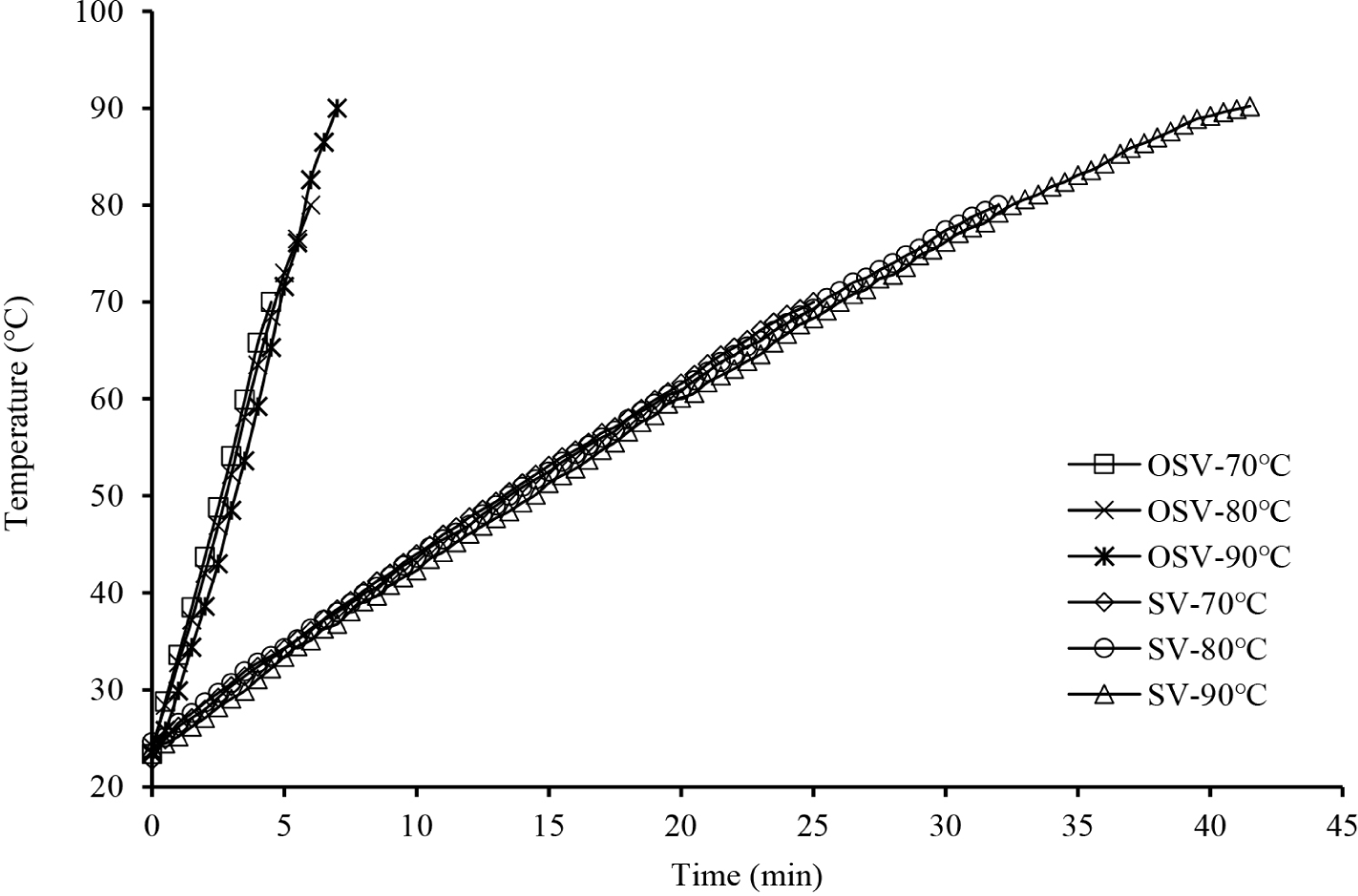
The OSV system achieved significantly shorter preheating times (4.5, 6, and 7 min) compared to the SV system (25, 32, and 41.5 min) to reach the respective target temperatures. Similarly, electrical energy consumption was significantly lower for the OSV system, requiring 0.021, 0.031, and 0.042 kWh to reach the target temperatures of 70°C, 80°C, and 90°C, respectively, compared to 0.5, 0.65, and 0.86 kWh for the SV system. These findings are consistent with previous research on OH, which highlighted its superior efficiency compared to conventional heating methods (Aydin et al., 2020; Tian et al., 2016; Tian et al., 2020). The significant two-way interaction indicates that the magnitude of the differences in preheating time and energy consumption between the two systems increases as the target temperature rises. These differences may arise from the distinct heating mechanisms employed by the two systems. The OSV system uses direct heating by passing electrical current through the water, generating heat internally and enabling rapid and efficient heating (Jan et al., 2021; Lyng et al., 2019). By contrast, the SV system relies on an external heating element to gradually heat the water, resulting in slower heat transfer and higher energy consumption (Alfaifi et al., 2023; Hobani et al., 2023).
Figs. 4A, B, and C and Table 2 illustrate the effects of cooking method, temperature, and time on various energy-related parameters, including electrical energy consumption, SEC, and energy efficiency, for cooking camel meat in the OSV and SV systems. The results reveal distinct trends driven by the interactions of these variables, highlighting the superior performance of the OSV cooking method compared to the standalone SV method. Electrical energy consumption and SEC both increased with rising cooking temperature and duration for both methods. However, OSV consistently demonstrated significantly lower energy requirements than SV across all conditions. For instance, at 70°C for 30 min, OSV required only 0.06 kWh of electrical energy and 0.32 kWh/kg of specific energy, compared to 0.57 kWh and 3.21 kWh/kg for SV under the same conditions. As cooking time extended to 120 min, the energy consumption of OSV rose modestly to 0.11 kWh and 0.44 kWh/kg, whereas that of SV increased sharply to 1.03 kWh and 5.79 kWh/kg, highlighting the pronounced inefficiency of SV during prolonged cooking.
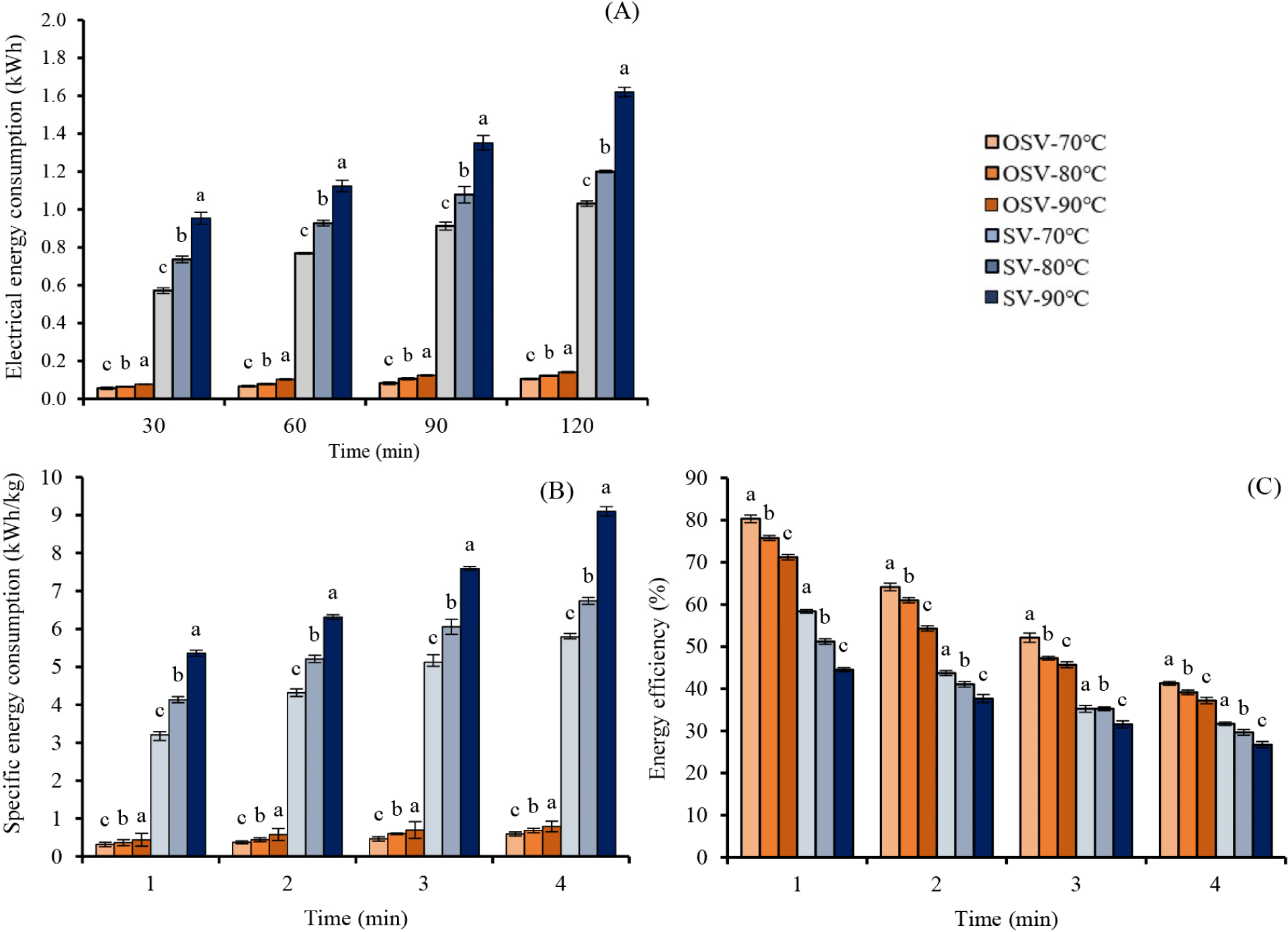
Energy efficiency showed an inverse relationship with cooking temperature and duration, declining in both methods as cooking conditions intensified. OSV achieved significantly higher energy efficiency across all conditions, reaching 80.3% at 70°C for 30 min, compared to only 58.36% for SV under the same conditions. At 90°C for 120 min, OSV maintained an energy efficiency of 47.31%, whereas SV dropped to a low of 31.68%. The superior energy performance of OSV can be attributed to its direct heating mechanism, which generates heat internally through electrical resistance and minimizes heat loss, consistent with findings characterizing OH as a highly efficient method for converting electrical energy into heat (Jan et al., 2021; Lyng et al., 2019; Ruan et al., 1999). Conversely, the SV method’s reliance on prolonged operation of a water bath results in significant energy consumption and lower efficiency. This inefficiency aligns with studies reporting considerable energy demands for SV, particularly when compared to conventional methods such as boiling and steaming (Aydin et al., 2020; Głuchowski et al., 2020; Nguyen et al., 2013; Oluwole-ojo et al., 2023). Collectively, these findings underscore the distinct energy-saving advantages of OSV over SV, especially under more intensive cooking conditions.
The statistical analysis in Table 2 highlights significant two-way interactions between cooking method and temperature (CM×CT), cooking method and time (CM×CI), and cooking temperature and time (CT×CI), as well as three-way interactions (CM×CT×CI) for all energy parameters (p<0.05). These interactions reveal amplified differences between OSV and SV under specific cooking conditions. For example, the energy-saving advantages of OSV became increasingly apparent at higher temperatures and longer cooking durations, where SV demonstrated a steeper rise in energy consumption and a more pronounced decline in efficiency. Notably, OSV achieved its highest efficiency at lower temperatures, while the inefficiency of SV worsened as temperature increased. Similarly, longer cooking times elevated energy demands for both methods, but the increase was significantly more pronounced for SV. These findings underscore the importance of considering cooking parameters holistically as interaction effects play a critical role in achieving optimal energy savings and enhancing cooking performance.
Figs. 5A, B, and C and Figs. 6A and B and Table 3 provide comprehensive insights into the thermal and physical characteristics of camel meat, influenced by cooking method, temperature, and time. The results reveal clear patterns across thermal conductivity (k), thermal diffusivity (α), specific heat (Cp), density (ρ), and cooking yield (Cy), demonstrating the interdependence of these factors on the applied cooking conditions. These findings align with previous research, which highlighted similar trends for thermophysical characteristics of meat (Dominguez-Hernandez et al., 2018; Hernandez et al., 2022; Mc Donald et al., 2002; Othman et al., 2018; Unklesbay et al., 1999).
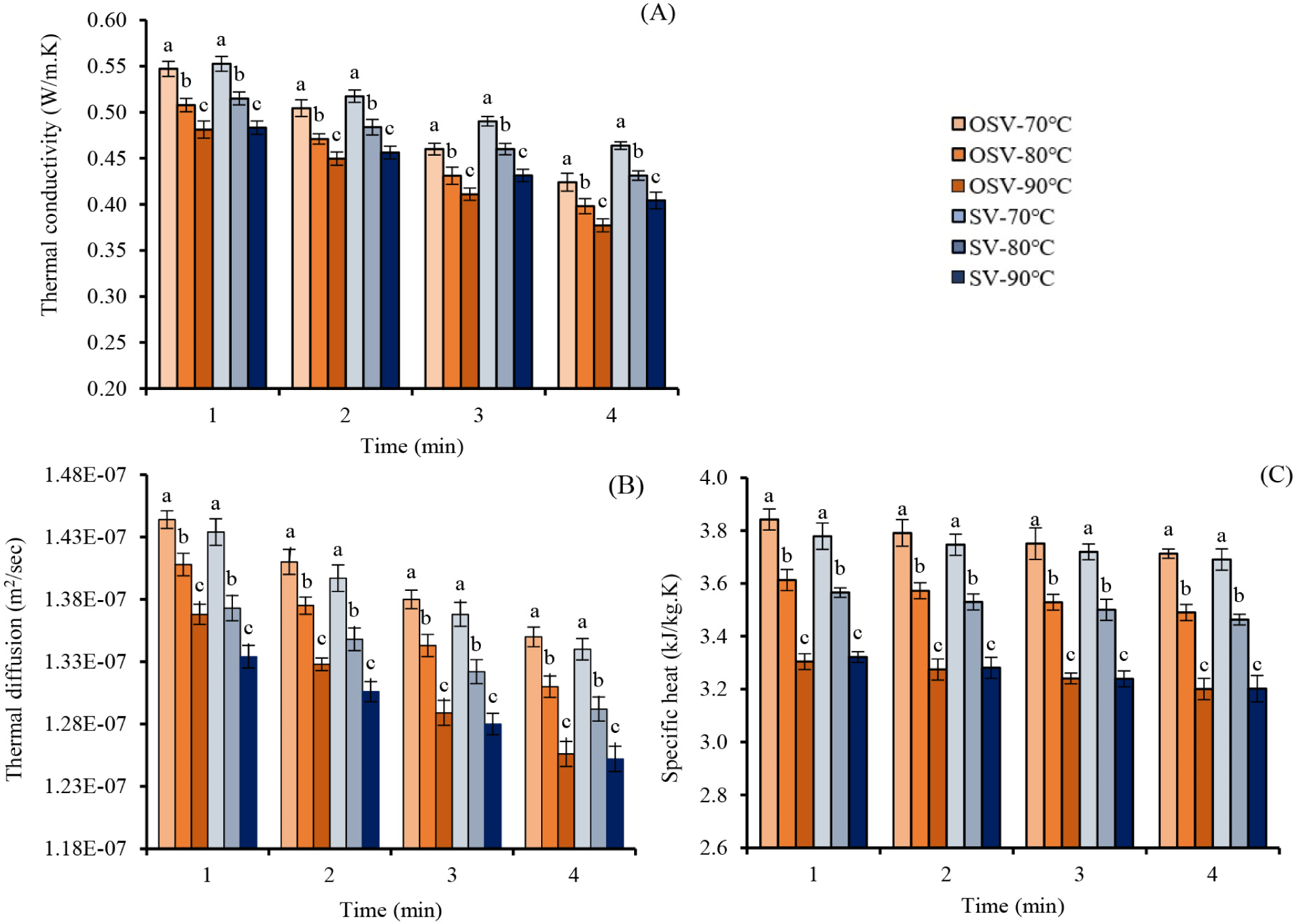
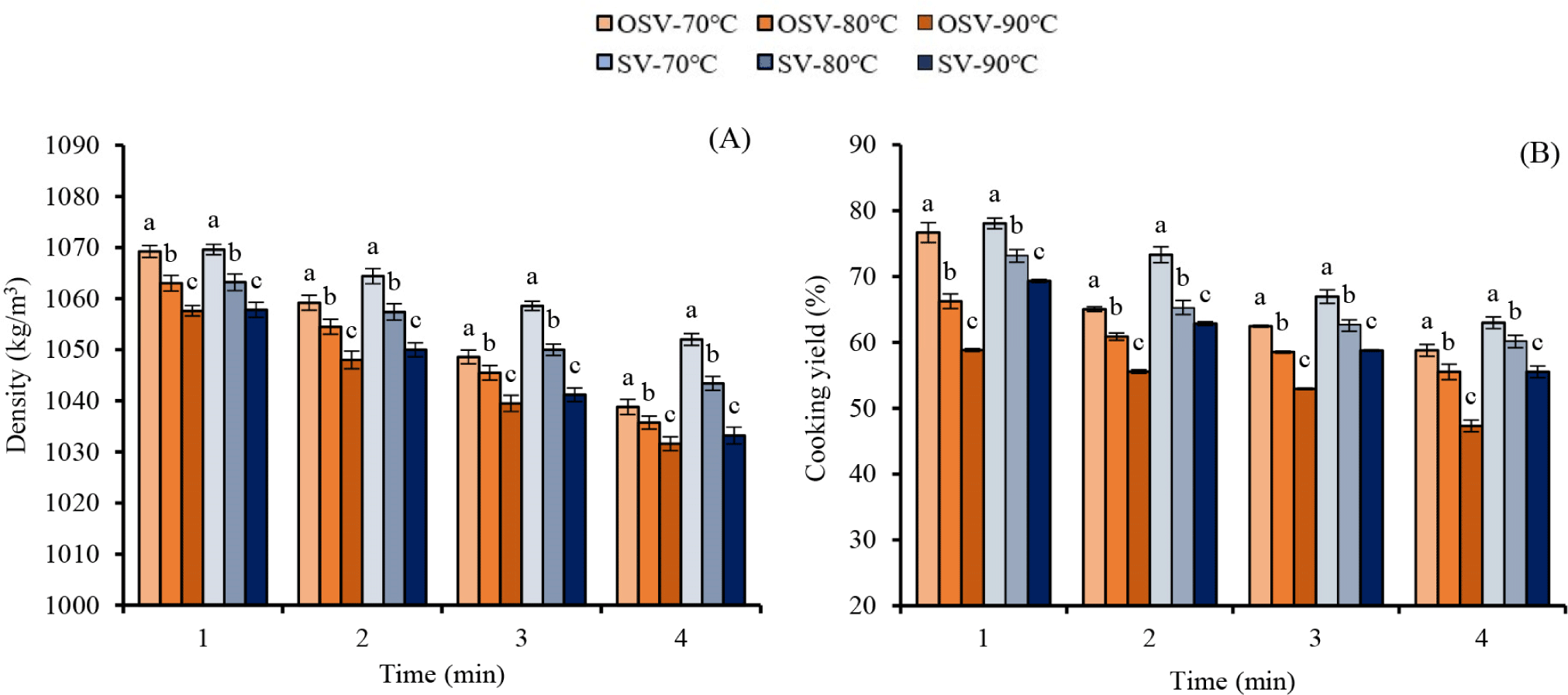
Thermal conductivity (k), thermal diffusivity (α), and specific heat (Cp) consistently decreased as cooking temperature and duration increased (Figs. 5A, B, and C). These declines can be attributed to the denaturation of proteins at high temperatures and prolonged cooking times, which release water and minerals from the protein fibers and alter the thermophysical properties of the meat (Hobani et al., 2023; Marcotte et al., 2008). OSV exhibited marginally lower thermal conductivity and diffusivity than SV, likely due to its more rapid heating, which minimizes water evaporation and structural degradation. Specific heat values were slightly higher for OSV than SV, reflecting better water retention due to shorter cooking times and more uniform heating. The trends observed here are consistent with findings that OH enhances denaturation and structural changes in meat by passing an electric current through the cooking medium and meat (Jan et al., 2021; Lyng et al., 2019).
Density (ρ) and cooking yield (Cy) also declined with increasing temperature and cooking time, as shown in Figs. 6A and B. The density of camel meat decreased in both methods, reflecting reductions in moisture content and muscle fiber shrinkage during prolonged cooking periods (Mc Donald et al., 2002; Oliveira et al., 2005). Interestingly, OSV-treated meat maintained slightly higher densities than SV-treated meat across all conditions, further supporting the advantages of OH in preserving meat structure.
Cooking yield, an indicator of retained moisture and mass during cooking, followed a downward trend with increasing temperature and cooking time across both methods. Interestingly, cooking yields for SV and OSV were more comparable at lower temperatures and shorter times. For example, at 70°C for 30 min, the difference in cooking yield was only 1.40%, with SV achieving 78.07% and OSV 76.67%. However, as cooking conditions intensified, the differences became more pronounced; at 90°C for 120 min, SV yielded 55.52%, which was 8.21% higher than the 47.31% yield for OSV. These differences highlight the distinct heating mechanisms of the two methods. The direct heating in OSV likely increases internal vapor pressure and fluid loss, whereas the prolonged exposure the water bath used in SV may promote moisture retention at extended cooking times. This trend aligns with previous findings that prolonged exposure in water baths during SV cooking facilitates greater moisture retention (Bıyıklı et al., 2020; Dai et al., 2014). Conversely, the mechanism of OSV, which relies on electrical currents passing through the meat and cooking medium, results in higher fluid and mineral losses due to increased denaturation and shrinkage of muscle fibers (Ángel-Rendón et al., 2020; Dai et al., 2013; Dominguez-Hernandez et al., 2018).
The ANOVA results from Table 3 underscore the significant interaction effects between cooking method, temperature, and time on all measured parameters. The three-way interaction (CM×CT×CI) was significant (p<0.05) for thermal conductivity, specific heat, density, and cooking yield, emphasizing the complex interdependencies of these factors. For example, OSV maintained superior thermophysical properties such as higher specific heat and density compared to SV, especially at lower temperatures and shorter durations, due to its rapid and uniform heating mechanism. In contrast, SV experienced a pronounced decline in these properties at higher temperatures and extended cooking times, likely due to prolonged heat exposure and moisture loss. These findings align with prior research by Bıyıklı et al. (2020) and Głuchowski et al. (2020), which noted similar trends in conventional cooking methods, reinforcing the potential of OSV to minimize heat losses and structural degradation.
The ANOVA results in Table 3 underscore the significant interaction effects between cooking method, temperature, and time on all measured parameters. The three-way interaction (CM×CT×CI) was significant (p<0.05) for thermal conductivity, specific heat, density, and cooking yield, highlighting the complex interdependencies among these factors. For instance, camel meat cooked using OSV maintained superior thermophysical properties, such as higher specific heat and density, compared to SV, particularly at lower temperatures and shorter durations, due to its rapid and uniform heating mechanism.
Additionally, two-way interactions (CM×CT and CM×CI) revealed distinct trends for both cooking methods. The interaction between cooking method and temperature (CM×CT) highlighted that the advantages of OSV in preserving specific heat and cooking yield were more pronounced at lower temperatures compared to higher temperatures. Similarly, the interaction between cooking method and time (CM×CI) demonstrated that longer cooking durations significantly reduced cooking yield and increased density in SV, whereas OSV mitigated these effects by limiting moisture loss through its direct heating process.
Furthermore, the interaction between cooking temperature and time (CT×CI) showed that, irrespective of cooking method, higher temperatures and longer durations amplified declines in thermal conductivity and specific heat, underscoring the need for careful optimization of these parameters to achieve desirable meat quality. These findings collectively emphasize the importance of a holistic approach in parameter optimization as the interplay between cooking method, temperature, and time plays a critical role in determining the thermophysical characteristics and cooking outcomes. The trends observed align with prior studies emphasizing the importance of optimizing cooking parameters to minimize heat losses and improve energy efficiency (Bıyıklı et al., 2020; Głuchowski et al., 2020; Pathare and Roskilly, 2016).
Table 4 highlights significant positive correlations between thermal characteristics (thermal conductivity, thermal diffusivity, and specific heat) and physical properties (density and cooking yield) of cooked camel meat.
| Characteristic | Density | Cooking yield |
|---|---|---|
| Thermal conductivity | ||
| r | 0.731 | 0.675 |
| p-value | <0.001 | <0.001 |
| Thermal diffusion | ||
| r | 0.777 | 0.520 |
| p-value | <0.001 | <0.009 |
| Specific heat | ||
| r | 0.891 | 0.668 |
| p-value | <0.001 | <0.001 |
Thermal conductivity showed a strong correlation with density (r=0.731, p<0.001) and a moderate correlation with cooking yield (r=0.675, p<0.001), suggesting that higher thermal conductivity aligns with better water retention and structural integrity during cooking, particularly in SV-treated meat. Furthermore, thermal diffusivity had a stronger correlation with density (r=0.777, p<0.001) than cooking yield (r=0.520, p<0.009), indicating its dependence on meat compactness and moisture content. These results demonstrated a strong positive correlation between density and thermal characteristics, which is consistent with the findings of Marcotte et al. (2008). The rapid heating involved in OSV heating minimizes structural degradation, preserving higher density values compared to SV. Specific heat exhibited the strongest correlation with density (r=0.891, p<0.001) and a notable correlation with cooking yield (r=0.668, p<0.001), reflecting the critical role of water retention in determining these properties. OSV’s ability to maintain higher specific heat supports improved retention of density and cooking yield, especially under milder conditions.
These correlations align with trends in Figs. 5A, B, and C and Figs. 6A and B, which illustrate declines in thermophysical properties with increasing temperature and time. OSV’s rapid and uniform heating mitigates moisture loss and maintains structural integrity, whereas SV’s prolonged water bath exposure results in greater water loss and reduced yields. These findings underscore OSV’s advantages in preserving meat quality and emphasize the importance of optimizing cooking parameters to balance energy efficiency and product quality.
Conclusion
In this study, a novel OSV cooking technique was introduced and compared with the conventional standalone SV cooking method for preparing camel meat. The results indicate that the OSV cooking method offers several distinct advantages, including lower electrical energy consumption and specific energy inputs, leading to higher energy efficiency, especially at the lower cooking temperatures and times. The overall cooking yield was comparable between the two techniques, suggesting that the OSV approach effectively maintained a desirable cooked meat output. Both cooking methods significantly affected the thermophysical properties of the final camel meat product; however, the OSV technique produced camel meat with lower thermal conductivity and density compared to the SV method. This suggests that the OSV process may uniquely affect the structure of the meat, potentially enhancing quality attributes such as tenderness and juiciness. These findings provide robust evidence for the superiority of the newly developed OSV cooking method over the conventional standalone SV method for preparing camel meat. The OSV technique effectively achieves energy savings and enhances efficiency while preserving or even improving the desirable quality attributes of cooked meat. The implications of this study are substantial as the OSV approach could promote more sustainable and energy-efficient meat processing, benefiting both producers and consumers. Further investigations are strongly recommended to comprehensively explore the benefits and potential trade-offs associated with this innovative cooking technique.














